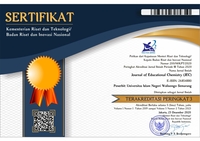Development of Interactive Learning Video at Grade X Senior High School
DOI:
https://doi.org/10.21580/jec.2022.4.2.12347Keywords:
ADDIE, interactive learning, video, chemical bondingAbstract
The lack of development of learning media in schools causes students to have difficulty understanding chemical bonding material. The use of chemistry textbooks in the study of chemical bonds is not enough to reduce the abstraction of the object of the study. The lack of use of the technology-based website in developing interactive video learning media is a major problem. Measuring the student's responses to the interactive learning video on the chemical bonding material. This study uses the ADDIE development model. This study begins by analyzing the problems and limitations encountered in chemistry learning. The quality of interactive video learning media with an assessment percentage of 92.5% by media experts, 91.66% by material experts, and 88.12% by teacher practitioners. Based on the results of testing on 31 students, the percentage of assessment was 84.66% which had a very good category. Web-Based Interactive Learning Videos on Chemical Bonding Grade X in Senior High School were declared valid based on expert and practitioner assessments. Results of the assessments of these experts consistently categorize H5P as very good or good. The general assessment of this video is very good and can be used. It consists of the background, objective, methods, results, and conclusion of the research.
Downloads
References
Apsari R A., Sripatmi, Sariyasa, Maulyda, M. A., & Salsabila, N. H.. 2020. Pembelajaran Matematika dengan Media Obrolan Kelompok Multi-Arah sebagai Alternatif Kelas Jarak Jauh. Jurnal Elemen, 6(2), 318-332.
Arikunto, S.. 2008. Prosedur Penelitian Suatu Pendekatan Praktik. Jakarta: Rineka Karya.
Atsani, L. G. M. Z.. 2020. Transformasi Media Pembelajaran pada Masa Pandemi Covid-19. Jurnal Studi Islam, 1(1), 82-93.
Budi K., Dedi I., & Nanda S.. 2017. Development of Chemistry Interactive Instructional Media Based on Mobile Learning on Oxidation-Reduction Reactions. Advances in Social Science, Education and Humanities Research, 3rd International Conferences on Education in Muslim Society (ICEMS 2017), 115.
Efendi, N. M.. 2018. Revolusi Pembelajaran Berbasis Digital (Penggunaan Animasi Digital pada Start Up sebagai Metode Pembelajaran Siswa Belajar Aktif. Jurnal Pendidikan, Sosiologi, dan Antropologi, 2(2), 173-182.
Herdini, Linda, R., Abdullah, Shafiani, N., & Darmizah, F. A.. 2018., evelopment of interactive multimedia based on Lectora Inspire in Chemistry Subject in Junior High School or Madrasah Tsanawiyah. Journal of Educational Sciences, 2(1), 46-55.
Khusniyah, N. L. & Lukam, H.. 2019. Efektifitas Pembelajaran Berbasis Daring: Sebuah Bukti pada Pembelajaran Bahasa Inggris. Jurnal Tatsqif, 17(1),9-33.
Majid, A.. 2009. Perencanaan Pembelajaran Megembangkan Standar Kompetensi Guru. Bandung: PT. Raja Grafindo Persada.
Miftahul J., Jimmi C., & Rasmiwetti. 2019. Development of Interactive Learning Media using Autoplay Media Studio 8 for Colloidal Chemistry Material. Journal of Educational Sciences, 3(1), 132-144.
Okta F., Susilawati & Linda, R.. 2020. Development of Interactive Learning Media using Autoplay Studio 8 for Hydrocarbon Material of Class XI Senior High School. Journal of Educational Sciences, 4(2), 296-308.
Petterson, F., Marstrander, T., Jorgensen, P. & Griff, S. T.. 2019. Activities: interactive content – H5P. Retrieved from moodle website: https://moodle.org/plugins/mod_hvp/.
Safira, I., Ismail, Taiyeb, A. M.. 2018. Pengembangan Media Pembelajaran Biologi Berbasis Web pada Konsep Sistem Pencernaan di Sekolah Menengah Atas. UNM Journal Of Biological Education, 1(2), 112-123.
Sanaky, H.. 2013. Media Pembelajaran Interaktif Inovatif. Yogyakarta: Kaukaba
Sanaky, H.. 2009. Media Pembelajaran. Yogyakarta: Safiria Insania Press.
Siagian, S., Mursid, & Wau, Y.. 2014. Development of Interactive Multimedia Learning in Learning Instructional Design. Journal of Education and Practice, 5(32), 44-50.
Downloads
Published
How to Cite
Issue
Section
License
The copyright of the received article shall be assigned to the journal as the publisher of the journal. The intended copyright includes the right to publish the article in various forms (including reprints). The journal maintains the publishing rights to the published articles.
Authors are permitted to disseminate published articles by sharing the link/DOI of the article at the journal. Authors are allowed to use their articles for any legal purposes deemed necessary without written permission from the journal with an acknowledgment of initial publication to this journal.

This work is licensed under a Creative Commons Attribution-NonCommercial-ShareAlike 4.0 International License.


